‘A paragraph should be like a lady’s skirt: long enough to cover the essentials, but short enough to keep it interesting.’ – Anon
In light of the above quote, I am quite certain that I often make intense literary criticism with my skirts. I philosophise with my culottes. I perform interpretive dance with my cut-off jeans. My clothes are an expression of who I am (and whether I can be arsed in the morning), and apparently they provoke a reaction in the people around me. They ‘say’ something about me. So it’s only right that I learn how to dress so that people ‘hear’ the right things when they look at me. So far, so logical, as far as dress codes go, but why is the emphasis always put on the woman being looked at, rather than the person looking? Why do I have to list all of the implications of what I’m wearing before I leave the house?
School is great for a lot of things. Social niceties, chit-chat, forcing yourself to get on with people you despise without poisoning them (studying, if you have the time and inclination). It allows us to practice being adults, without the repercussions, and dressing appropriately is a part of that. You won’t get office jobs if you dress inappropriately, according to what society deems appropriate, and that includes wearing revealing clothing. Schools have a duty to educate us about these societal rules, but what I have an issue with is gender-policing, masquerading as education.
The way dress codes are being enforced against young women is a topic that’s been in the news a lot recently, both here – where 250 girls were sent home from Ryde Academy last week for having skirts that are too short – and abroad. In New Jersey, a group of schoolkids have launched a social media campaign, called ‘I Am More Than a Distraction’ against punishing young women for their clothing choices (one girl was made to wear a baggy shirt over her existing clothes as ‘punishment’ for them being too revealing. Last month, a girl who was banned from prom for being ‘too slutty’ and distracting to the dads hit back against the school in question with a blog post that went viral. Meanwhile, a girl in the Canada is taking on her school’s ‘finger-test’ (where your skirt or shorts can be no shorter than where your fingers fall when they’re by your sides). Embarrassed in front of her class and being told her short shorts were ‘a distraction,’ she’s spoken out about the onus being placed on girls and young women to dress ‘acceptably’. She also, in a completely badass move, papered her school with signs reading: ‘Don’t humiliate her because she is wearing shorts. It’s hot outside. Instead of shaming girls for their bodies, teach boys that girls are not sexual objects.’
In response, a lot of commentators are writing her off as brattish, as someone who does not want to conform to rules that are there to train her for the real world. But the thing is, these rules don’t seem to be in place because the students, male and female, need to dress smartly. It is so that girls don’t become a distraction to the boys. And that is where this story stops being about teenage rebellion, and starts being about the sexist crap that women have to deal with from the point they hit puberty.
I remember being at sixth form and having a similar dress-code (no strappy tops, no cleavage and the top and bottom halves of your outfit MUST MEET IN THE MIDDLE, GIRLS!) We were part of a girls’ school, but there was a boys’ school right next door, and the sixth form common rooms could mix (I’m not even going to get started on the fact that the boys’ common room had vending machines and a foozball table, and the girls’ common room had a kitchen….hello stereotypes!) Nearly every time we were told to adhere to the dress code, it was because female bodies were deemed ‘a distraction’. Notices went out saying that, although it was hot, girls shouldn’t really take off their cardigans and wear only their strappy vests whilst sitting outside on the grass. Another notice went out about the increasing visibility of cleavage and how this was a ‘distraction’ to staff, although it was noted that it was female staff, not male who had pointed this out. Those who dressed alternatively were often picked on, too (girls who dressed more conventionally got away with shorter skirts, for instance). Cropped trousers were banned as a ‘gateway’ to shorts (it’s a downward spiral, guys). Even in our final week, which had fancy-dress theme days, there was talks of cancelling it unless the outfit ‘was very obviously a costume.’ By the end, we begged for a uniform.
Take more than a cursory glance at tumblr and you’ll see that the number of posts that address the issue of ‘dress codes’ is increasing by the day. Young women are are speaking out and fighting back, and I, personally, am glad to see the next generation of feminists pointing addressing the flaws with a system that teaches a fifteen-year old girl that it is her responsibility if she is objectified.
(signs via tumblr)
(via tumblr)
In reality, it’s fairly easy to tell if a dress code is sexist. Does it apply to girls only? Is it predicated on the assumption that a bit of exposed flesh will drive all males present to distraction? Does the enforcement of it involve publicly humiliating young women by berating them in front of the class, making them wear big baggy shirts over their existing clothes, or standing them up against a wall?
When Everyday Sexism has reports of sexual harassments from schoolgirls, harassed whilst wearing their school uniform, we know it’s informed by a culture that teaches a woman her body is not hers (not to mention pornography that fetishists youthful schoolgirls). This failure to ascribe women agency is the same kind of mentality that asks how short a woman’s skirt was when she was assaulted or values her solely on how she looks. It expects women to become bastions of morality, keepers of virginity, walking, talking breasts-and-vaginas. It disrespects men because it relegates them to the realm of gawping, hormonal caveman, unable to function because BOOBZ. If we teach boys that the way a girl dresses is directly related to whether or not they will distract them, how can we expect them to not view a low-cut dress as a means of enticing them, rather than just as a piece of clothing?
I am not saying that there should be no dress code in schools; I think they are important. They have a place educating young people about how they present themselves, and that will be relevant in the workplace later on. I just don’t think that the emphasis should be on a quite frankly antiquated and insulting idea about women’s bodies. A dress is just a dress, not an enforcement of a patriarchal morality, and the faster we all acknowledge this, the faster my skirt becomes an item of clothing again.
- Sairah Rehman


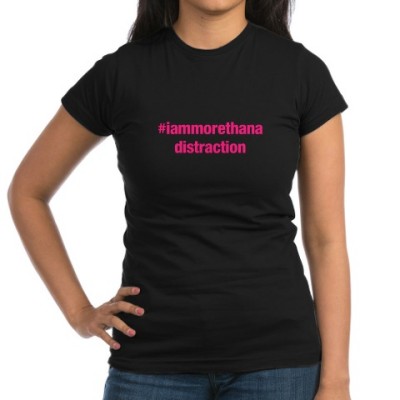
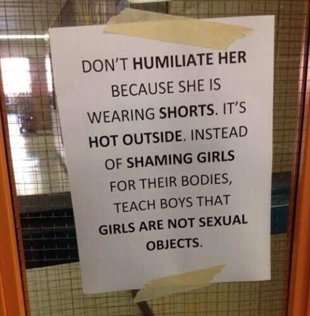
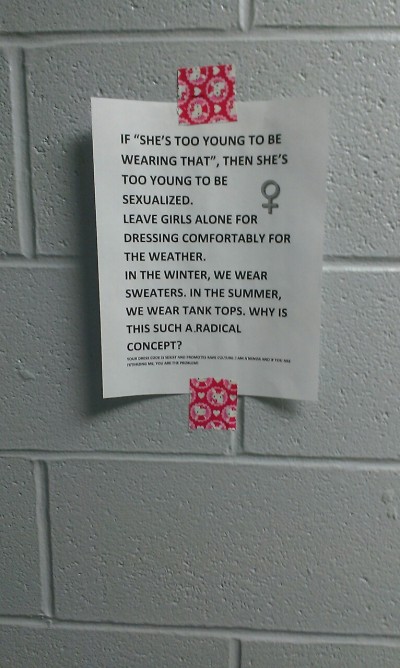
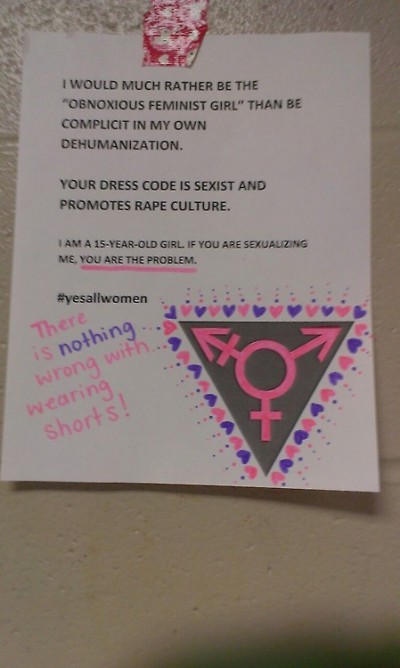
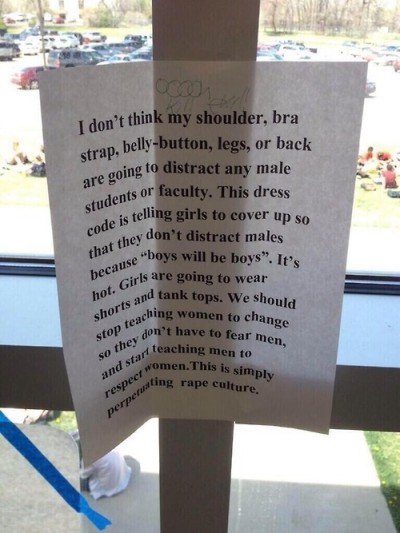

Ha, a company I used to work for banned leggings because, quote “some women in this company are too fat to be wearing anything that tight”. Incredible…
‘If we teach boys that the way a girl dresses is directly related to whether or not they will distract them, how can we expect them to not view a low-cut dress as a means of enticing them, rather than just as a piece of clothing?’
Fantastic point. And a geeat article. So prous of young girls who are standing up to this nonsense. Would love to see the teachers’ red faces.
I understand and agree with the fundamental impetus behind this argument, and that the reasons people give for dress codes are sexist and outdated – but I do think dress codes are important and being respectful with your attire is essential. wearing short shorts to school or work is just plain wrong – whether you’re being looked at ‘as a sex object’ or not. nobody wants to see your butt cheeks.
Don’t look then
yes we do!!!!
I think dress codes are important. I get the point about people needing to realise that nobody is a sex object regardless of what they wear and it’s essential everyone learns this but I also remember what it’s like to be a teenager. When I was 16 if a guy leaned back on his chair and showed a flash of stomach *boom* hormones were going and it could be a good 20 minutes before I was back to being able to fully concentrate on school work. Or a girl showing some leg/cleavage and I was stuck feeling bad comparing myself to her for the next 20 minutes. It wasn’t because I was objectifying the guy or judging the girl or I just needed to be taught not to look at them at all or have any response, it’s just the experience of being a teenager. It’s the time we start to learn to cope with being attracted to people but not letting it knock us off our stride, when we learn to be comfortable with ourselves but that comes with time and usually once we’ve made it to the other side of puberty. Yes, we’re all (including boys) more than our hormones and everyone is capable of self restraint but being distracted by someone is involuntary especially as a teenager. Telling people to just not be distracted/don’t look is to totally oversimplify a complicated issue and completely misunderstand people’s normal involuntary responses. I like baggy uniforms. We all look horrible so it helps with being self conscious about bits of ourself or fashion choices. We go to school to learn about things, not worry about how to present ourselves or worry that the person we fancy showing skin just made us miss what the teacher said. Uniforms and dress codes do this. There’s time for working on getting that headrush time down out of school.
You say you needed to be taught not to look at people. Homogenising people isn’t teaching you not to look it teaches people (overwhelmingly girls) not to be seen
And y’all, let’s never forget the cheerleader exemption.
Those uniforms are in no way distracting.
Ever.
Right?
Don’t blame that on them. Sometimes they have no control over it. There are always volleyball players (spandex) and swim team in tight bathing suits.
It’s part of those sports and activities so don’t blame them for doing what they love.
I see your points, and in a way I agree that schools are not happy with the sexualisation of young girls. But I have to say that as a teacher I completely agree with a skirt policy. At our school boys wear shirts, ties, blazers and trousers all year round. There is no shorts option for them, and all summer boys are sweating away in their uniform. But given the choice the students say they prefer the uniform: it’s an easy decision in the morning, they feel important and part of a community when wearing it, and it does prevent bullying. We have had this discussion at length in the run up to “you can now take off your blazer” season. Why is it then, that girls are given the choice of skirt or trousers? Surely feminism means equality. If we want to be equal then girls should also be wearing the trousers that keep the boys looking so smart. And yet, they choose the shortest, tightest skirts imaginable and I find myself daily asking girls to pull their skirts down. It is not a matter of sexualisation. I see their pants, and it is not something I want to be faced with when trying to tackle shakespeare or linguistics. My head teacher likes to remind the girls that it is a matter of dignity. As women they are allowed to choose their uniform, a luxury that is not given to the boys. It is the girls who choose to push this boundary, and it is with a heavy heart that I hear of girls being bullied for skirts that are too long. The children in their way have embraced the sexualisation and we, as the adults responsible for their well being, are coping as best we can with the ever present reality that children are not children anymore. Protest all you will, but I say that true equality of the sexes would mean trousers for all. We’ve got more than equal rights (which is fortunate as I am not a trouser woman) but girls just seem to take this too far. This is even true of staff, since women do not need to wear the same blazer/tie work uniform that men are required to. Does this then mean that we should get everything out and claim that it is all just part of expressing our rights as women? I would rather be professional and acknowledge that in work, everyone should maintain a professional standard. I don’t see men’s bums or cleavage at work, and they should not be forced to look at mine.
Or, allow the boys the shorts option – it was available at my school, though the boys rarely wore them for whatever reason. Its like office wear – the men are in trousers, shirts and ties and women are in… well anything that is passable, from smart to smart casual. As a receptionist, I have to wear a uniform, a plain grey dress that covers my decolletage and is down to my knees (even though someone said it was sexy – hello porn fantasy) and I’m grateful for it so I don’t have the social dilemma of picking out an outfit. I really do envy blokes and their narrower choice.
Its one of these debates where it is a fine line between sexualising a school girl and enforcing the rules of a uniform and a dress code simply to maintain a professional status. I’m all for women standing up to wear what they want without expecting attention or a backlash but I also understand the need for a dress code in certain circumstances – like dressing for an interview. Its tough and leaves me conflicted and befuddled!
Agree that skirts/shorts should not be too short. Shorts are no cooler than skirts, I should think. Girls having to wear trousers – why. It may be inappropriate for health reasons. BUT SURELY YOU HAVE NO RIGHT TO TELL A CHILD WHEN THEY ARE FEELING HOT, “YOU CANNOT REMOVE YOUR BLAZER. IT ISN’T THE RIGHT ‘SEASON’.” I certainly would NEVER do that when I was teaching. Infringement of human rights, I would suggest.
Why trousers, let everyone wear skirts.
You are my favorite.
with my legs!!!!!!!!!!!!!!
My head teacher likes to remind the girls that it is a matter of dignity
Respectability politics is a tool of the patriarchy
I completely agree with you Jennifer! It’s a question of dressing appropriately – for boys AND for girls. Perhaps it is the schools’ reasons for such enforcement, in the article at least, which are worded a little wrongly.
Right on girls. In school we had to wear school uniforms and were punished for not wearing the school uniforms. Not because we were “too sexy” etc. I’m glad slut-shaming was not part of my school experience.
If schools want a dress code, make rules that aren’t based on the assumption our bodies are dangerous to men and their attention spans e.g. choose a professional dress code which is applied to both sexes and is suitable in warm and cold weather.
It used to bug me when I was at school that sixth form girls were asked not to wear sleeveless tops because their bare arms (seriously) were distracting the boys, while at the same time the younger girls were forced to wear ghastly gym knickers (that it was a struggle to keep all of your pubes tucked into for many) to run in during PE, while the boys wore nice big shorts.
That sound like a very pervy school you went too
You should have met the German teacher, he had a big stuffed toy in the corner of his classroom that he referred to as his ‘hairy triangle’ (at least I think he did, whenever I remember that part it seems so unbelievable that I think I must have dreamed it).
I am all for school uniform- having a set skirt length, or trousers, shorts in summer, specific blouse, sensible flat shoes etc as it stops the school becoming a fashion parade of ever expensive items. Having said THAT, a uniform should be practical, comfortable and not hinder children in their activities. Gender should not come near it- same rules, same choices for both sexes. The whole point to stop competition, to stop kids focusing on appearance and to ensure they are wearing the attire that allows them to be active without embarrassment.
Ah this one is pretty easy I reckon- school uniform for all. Exact same for both girls and boys. Trousers for the winter, shorts for the summer with knee length regulations.
Theres not many girls OR BOYS who can make regulation grey nylon baggy knee length school shorts look hot. Distractions minimised, lets let everyone get back to the utter horror that is being a teenager.
If girls are forced to wear a uniform then boys should have the exact same uniform. I don’t think young women should be held aside and be sexualized in any situation. However I lived in Australia for a year and my boyfriends daughter “who would look sexy if she wore a garbage bag” talked with me about her feelings on this matter. Boys in her school wore shirts and blazers and they did this with school pride. The girls had a choice of pants or the very school girlie uniform. I learned that you were unable to see with you’re eyes if you parents had money . You had no idea about who a person is until meeting them. When all you have is school and sports somehow the attention one would get would come from scoring high on tests or winning a wrestle match. Uniforms weren’t meant to be used in this context, but hey it really worked in furthering the kids education. If I had a choice between uniform or my wardrobe when we were kids I’d be happy to get noticed for who I am rather than give some kiddie a peek.
Most teenage girls dress like top sluts because they do want the D! And it is all for attention….that’s why I did it! Thankfully i grew out of it! If i ever have a daughter i’d give her a good slap if she was wearing tiny tiny shorts!
Is this ironic?
I remember a teacher chasing me halfway across the school to tell me off for wearing over the knee socks to school once (it was painfully cold and I wore them over flesh coloured tights for a bit of insulation). I pointed out to a teacher that the uniform regulation specified black socks, not the length, but no – apparently they were inappropriate for my age and I was giving people the wrong idea.
They were socks.
Hear that folks? Socks = promiscuity.
I live in America where most schools don’t have a uniform, however my middle school (ages 11-13) did for some reason… it was a pretty chill uniform, basically a polo shirt in your choice of color as long as it had the school name embroidered into it and khaki or black bottoms (trousers, skirts, shorts, etc were all acceptable). During my time there I saw girls being forced to stand in front of the class and measure her skirt to make sure it was long enough. Meanwhile, this was during a time when it was “cool” for guys to wear really baggy clothes. Some boys at my school were wearing pants so low their underwear was clearly visible, and shirts so baggy I could have brought them camping and used them as a tent. But the teachers said nothing. The boys underwear showing was seen as silly teenage fashion trends. But a girl showing an inch too much thigh? Not allowed.
This is an interesting article and a very thought-provoking discussion, but I wonder if anyone might illuminate me as to where the line sits between a defensible dress code and an indefensible reification of a certain vision of women’s bodies? It seems to me that the dispute hinges upon this very line. As I see it, the Ryde head-teacher etc. would claim that a defensible dress code actually defends against such a reification, since it forbids choices which reinforce sexualised stereotypes (in other words, that the line is drawn to encompass worries about sexualisation). Opponents claim that such it is the existence of such a thickly drawn line that reinforces those stereotypes, right? Were the line to be drawn thinly around the utilitarian benefits of school uniform (which apply to boys and girls), allowing for a much wider realm of self-expression, such expressions could be discussed independently so as to challenge sexualised stereotypes.
If I’m right here, the one thing we cannot do is to be laissez-faire towards individual choice. The problem of the sexualisation of women’s bodies is circular, in that it does not just exist within men or women. Men do the objectifying, thus creating potentially false standards that women feel they need to live up to, thus reinforcing objectification. If this circle is to be broken amongst children, someone needs to intervene; if it isn’t to be schools (by way of preventing girls from falling into objectifying stereotypes and, in so doing, preventing boys from internalising such stereotypical standards against which they learn to judge women), who is it to be?
One last thing: I am aware that the above paragraph reads as if the onus is on women/girls to pay the price of stemming their own justification. Note that the duties imposed upon boys and girls don’t change a bit if we turn them around (such that we intervene to prevent boys from seeing women as sex objects and to prevent girls from seeing themselves as sex objects). So I don’t think I fall into that trap.
Loved this so much! I I’m proud to be part of the new generation of feminists rather than shying away from the ‘dirty word’ because like the article says I’m not going to sit back and watch my gender be dehumanized
I’m sorry but this is rubbish. I am a teacher in a large secondary school. Our uniform policy is strict and it does prevent girls from wearing leggings and shorts (although many do it anyway) but the point is not because they are a “distraction” for the boys, staff or anyone else. When I see girls at school in extremely short skirts – and I’m talking bottoms hanging out, seeing underwear etc, – I am upset because it seems like they are sexualising themselves. Women can wear what they want and I FULLY support that but girls? That’s a totally different story. We sometimes have non uniform days and all day long I look at girls’ bras and midriffs and I don’t like it. But not because of what the boys might think but because I don’t feel like that kind of dress is appropriate for a school setting. At underage clubs, etc, they should be free to wear what they like. And by the way, boys have to dress appropriately at all times too. By having these guidelines in place we are not shaming the girls at all; on the contrary, we are encouraging the non-sexualisation of girls who are under the age of 16.
At school, a female teacher taught our class that if a girl wears revealing clothes then she is asking for it and what happens to her is her own fault. She used me and my short school skirt as an example. I was 12.
Brilliantly written, and some amazing young women standing up for themselves and their friends by making marks on the attitudes towards women.
I went to a mixed secondary school where we were required to wear a uniform and one week of hot weather a few of the girls in my group of friends decided they would wear skirts. As soon as they turned up that morning there was questions asked by all teachers as to weather they were appropriate for school. They had a lengthy discussion about it and came back with the decision that they were not to wear the skirts the next day for the following reasons;
1). Not the correct attire for school – completely understandable. When we were talking between friends about weather it was a good idea, we knew there would have been a chance that the skirts wouldn’t have been allowed; living in the North of England and not seeing very much sun, there wasn’t a rule that skirts weren’t allowed or how long a skirt must be.
2). Boys were looking up the girls skirts while they were going up the stairs (which all students would have used at least once a day to use classrooms) – a small number of boys felt the need to purposely stand further away and therefore lower than the girls when walking up the stairs to try and see underneath their skirts. Had those boys walked up the stairs as they would have normally when the girls were wearing trousers, there would not have been an issue. So rather than inform the boys that their actions were wrong, and the way they were behaving was inappropriate, the girls came back to school the next day wearing trousers after being told that what THEY were wearing was inappropriate.
The issue here isn’t school uniforms, teenage rebellion or testing authority. It’s that the males around us aren’t expected to take responsibility for their actions and us women are being told that it’s our fault. The attitudes then follow us into adulthood and not just into the professional world but every aspect of a woman’s life. If we don’t want a man to leer at us don’t wear a top that shows our cleavage. If we don’t want to be talked about crudely don’t wear that skirt that shows your legs. If we don’t want to be raped then stop being women with with women parts and clothes which show those woman parts.
Once these beliefs are put out there for young women and men to absorb, then they’ll believe that it’s okay for men to say and act and do whatever they please to/about a woman and her body parts, as long as those body parts are not covered my material, obviously.
Lot of great comments here, a lot of stuff I agree with: that often dressing for comfort is misconstrued as ‘sexualising’ or ‘distracting’.
But what about fashion that is hardly about comfort, like short shorts that show off a lot of a wearer’s butt, or unbuttoning the front button to reveal underwear, and so on. I don’t know what to make of this? Should this be acceptable in schools? Should this be totally alright in ‘professional settings’?
I guess if we truly were able to respect each other people and not just seen as bodies, maybe?
I know that our society today has extremely sexualized woman. And this is something we need to correct and take a stand on, but the fact of the matter is when woman dresses in an inappropriate way, they are a distraction to male students. We are so much more than a distraction, and no one is telling you that you cant look beautiful when showing a little cleavage, or wearing shorter shorts. However when school is the only place where “you have to look cute to impress other people” or “you have to show a little skin to get the boy to notice you”. If boys are looking at you more because you are showing more skin, those are not the boys you want to notice you. I realize that many of you think that dress code is ridiculous and should just be eliminated so to not make women feel like they are just distractions. But if you want boys to start changing their natural behavior, then maybe you should start thinking about yourself not as a distraction, but a woman who is too good for boys, who can stand up for herself no matter what she is wearing. I propose that we continue with dress code AND teach boys not to view women as merely sexual objects. I do agree that boys need to be taught not to view women as objects or playthings, but as women we have more control over our sex drive then men. In order to help them to not think of us as objects, we need to dress in a way that honorers them as well.
At my school we wear a uniform. Everyone wears a blazer, white shirt, tie. And boys wear trousers, girls can wear trousers or a skirt.
I see nothing wrong with this as it is what happens in the real world. But what i do see a problem is the fact that at our school “slim fitted” trousers are inappropriate. Why? Are they a distraction? In MOST jobs where you are required to dress formally, you may wear slim fitted suit trousers, so why not school? Where they prepare us for the real world.
My trousers are from the SCHOOL UNIFORM section at the shop. I should surely be allowed to wear them? Apparently not. I do hope one day, someone has the courage to speak to someone who is in charge of uniform and raise these points.
I used to work for a small/medium sized local estate agents. They had 13 offices scattered around the North-West of England. 85% of their staff were female. Only about 15% of their senior staff were female. Until recently, when I found out long having left the company, they had finally (for financial reasons I might note) retracted their policy, junior staff were to wear a uniform.
So far so reasonable, right? I mean, it gives people a way of identifying the junior from the senior staff, right? Wrong. Does your opinion change when I tell you that only the junior FEMALE staff had to wear a uniform. Male staff were trusted to choose appropriate work attire, whatever their rank in the company. Woman on the other hand, in particular the junior female staff, were provided an outfit they were enforced through contractual obligation to wear (the fact that it was entirely hideous, often caused me to be confused with Sainsbury’s staff when I popped in for groceries over my lunch hour, and that no matter how big a size I asked for, the seam on the trousers always split, and the button on the blouses would always pop open, is to me besides the point).
I questioned this with the company director – who happened to be a long-standing family friend and for me, not a big scary boss, but the nice man who came for dinner with my parents, and whose cheeks turned red when he drank too much wine. This nice, red-faced, wine-drinking, senior company director told me, with no hesitation, no sense that what he was saying was SO absurdly misogynistic, not even the slightest idea that it might be offensive, sexist and derogatory, that the reason women were to wear a uniform where the men don’t was because when they trialled the idea of no-uniforms, some of the women proved to be a distraction to the male staff. Silly women we were, wearing clothes, and having breasts and legs. Cover them up quick! Lest you distract a man who is grown enough to be in a working and professional environment.
Also, I was told in no uncertain terms to stop complaining about it… when I followed up with an (unanswered) question as to why the men didn’t have to wear a uniform too, that my issue wasn’t the look and feel of the uniform, but the fact that only women were to wear them… because the policy wouldn’t change, and I quote “just because you don’t like the pattern on the shirt and want to wear more ‘fashionable’ clothes”. Well I could see where he was coming from, naturally, being a women, the fashion element at play here was OBVIOUSLY my most pressing concern *sarcastic face*
That was in 2008. TWO. THOUSAND. AND. EIGHT. A few years later I hear from another Director in the company that they had stopped the uniform policy, because the cost of replacing them when they eventually fell apart was too expensive.
Progress? I think not.
Bastards. I agree, not progress. Such a shame. Why should we be penalised because Men can’t be responsible for their dicks? They are grown enough to know that they shouldn’t be perving on us but that makes no difference. This is a fundamental issue in society that us women have to compensate for what guys just can’t handle. Well done for speaking out. I’ll be using this in my next lesson on Feminism at work. Great inspiration.
My school had a strict uniform policy and we weren’t allowed to wear trousers, only below the knee grey skirts from the uniform shop. No trousers, also they told us not to wear dark colored bras as you could see them through the shirt and it was distracting, but they are the shirts they told us to get. So I had to walk to school in the snow and ice wearing a freezing skirt, blazer and see through top. Wow great equalizing uniform policy.
UK